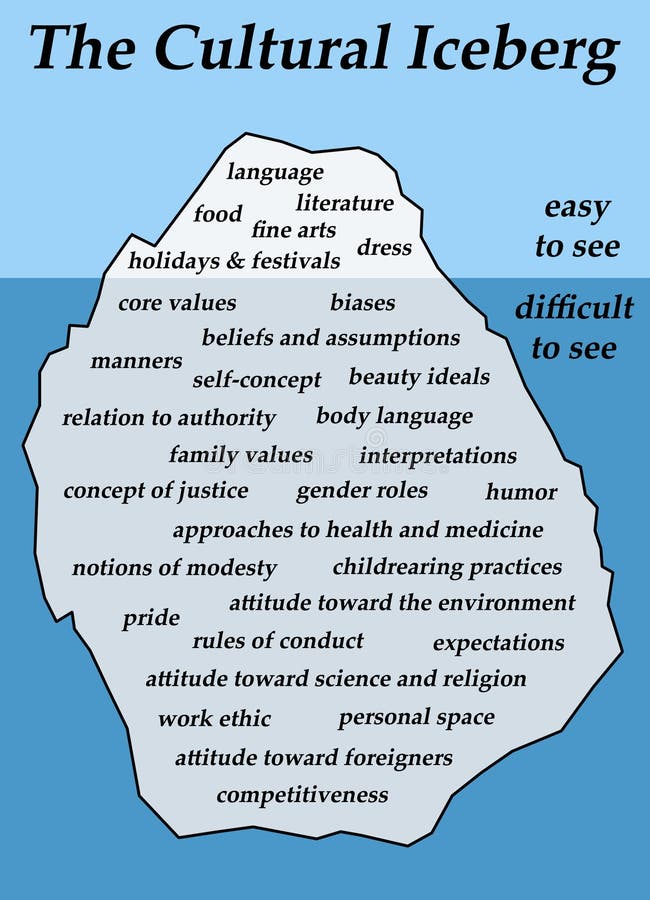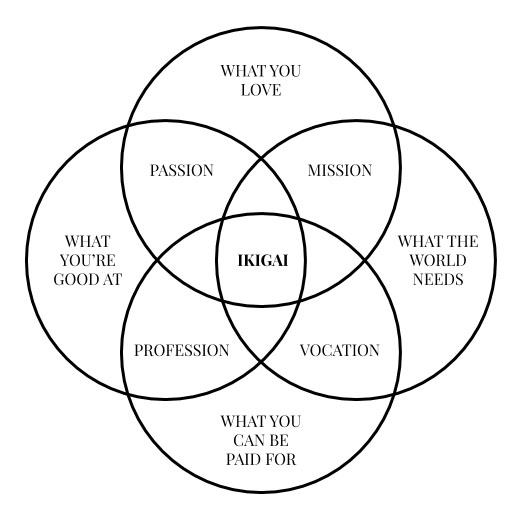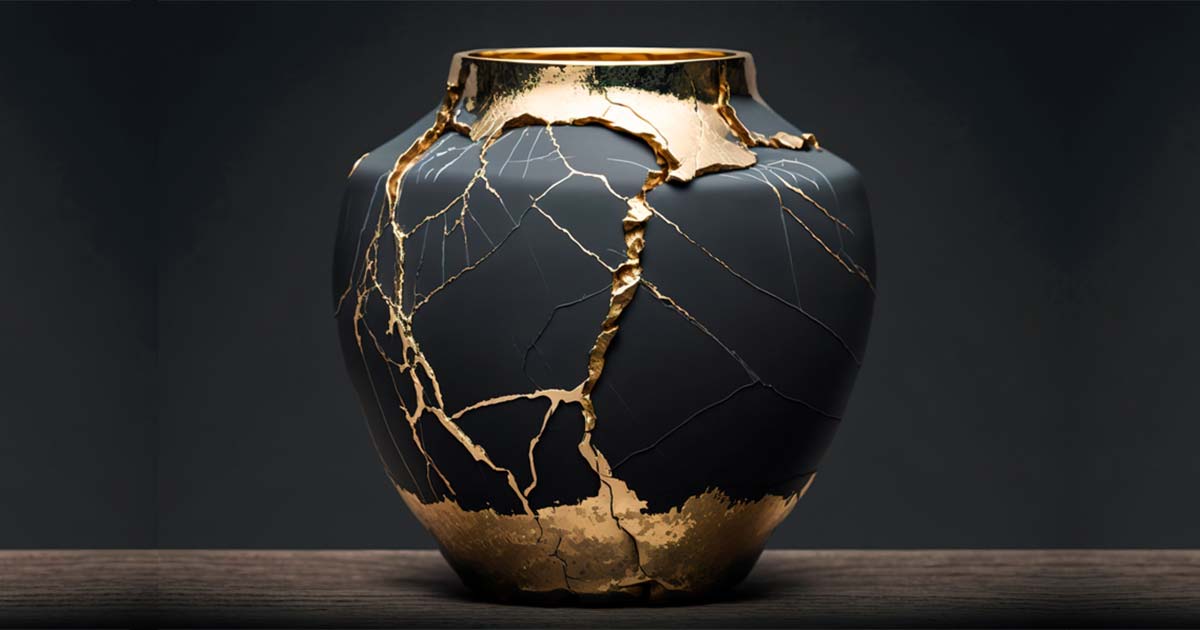
Embark on a journey to well-being with these four profound Japanese concepts: Ikigai for purpose, Moai for community, Hara Hachi Bu for mindful eating, and Kintsugi for resilience. Discover insights to a healthier and happier life in the modern world by embracing the ancient wisdom of Japanese culture.
Culture is a powerful force that influences the type of person we become. In the pursuit of well-being, different cultures can often teach us different lessons on what it means to live a good life.
First, what is culture? The American anthropologist Edward T. Hall created the “Cultural Iceberg” framework to help us analyze the many factors that determine what a culture is. The theory illustrates that only 10% of culture is what we see (language, diet, music, fashion), while 90% of culture is hidden from us (beliefs, values, norms, and expectations).
Here’s what the “Cultural Iceberg” looks like:

Generally we see the culture we grew up in as the default mode of being. This includes how people dress, what people eat, and what music they listen to, but also deeper aspects of life such as beliefs, values, morality, and how people approach life from a broader perspective.
Culture, tradition, and social norms shape our map of reality, the choices we make, and how we navigate our world. If you’re raised in a society that only values materialistic goals like money, fame, or popularity, you’re naturally going to live a life in accordance with those values, especially if they go unquestioned.
When we explore new cultures through traveling, reading, or meeting new people, we learn that there are many different ways we can approach life and the way we were raised isn’t necessarily the only way to live.
One simplified but general way we can categorize different types of culture is Western vs. Eastern ways of thinking. Western cultures tend to be more individualistic, rational, and materialistic, while Eastern cultures tend to be more collectivist, holistic, and spiritual.
Keep in mind, these are broad categorizations. Every country and culture is different. This also isn’t a judgment of “right” or “wrong” ways of thinking, but rather observing different personality types on a cultural scale.
My experience from a Western perspective is that learning about various aspects of Eastern culture and philosophy (such as Buddhism, Taoism, or Confucianism) gave me a taste for different ways to look at the world and different perspectives on life that I otherwise wouldn’t have been exposed to.
One popular country to look at is Japan which has a rich history, deep cultural roots, and long-held traditions that have been passed down over multiple generations. In this article, we’re going to cover four powerful Japanese concepts that provide universal lessons on how to live a healthier and happier life. Each concept reveals core values and beliefs that shape the way many Japanese people live.
These powerful ideas include: Ikigai (“a reason for being”), Moai (“meeting for a common purpose”), Hara Hachi Bu (“belly 80% full”), and Kintsugi (“golden repair”). Now let’s dive deeper into each one!
Ikigai
a reason for being
The Japanese concept of “Ikigai” is about finding a purpose in life. It directly translates to “a reason for being,” and it’s often described as the intersection between what you love, what you are good at, and what the world needs.
Ikigai is a combination between intrinsic motivation (an activity you enjoy doing) and extrinsic rewards (an activity that creates value in the world and improves people’s lives). Psychology research has shown that ikigai is associated with elevated feelings of dedication, accomplishment, meaning, and fulfillment.
This is in contrast to a lot of other cultures that just see work as a means to a paycheck or higher income, rather than reframing work as something that serves a higher purpose, both to yourself and society as a whole.
Ikigai has been shown to benefit both physical and mental health. It can reduce stress and anxiety, which contributes to longer lives and less risk of cardiovascular disease and other ailments. In addition, ikigai is associated with greater resilience in the face of negative events. One interesting study found that ikigai helped people better cope with stress after an earthquake or natural disaster.
Here’s a visual of what constitutes ikigai:

If you can find activities that meet all of these requirements, then you’ve found your ikigai.
Discovering your ikigai can take time and patience though. It involves careful introspection, understanding your strengths, passions, and talents, and finding ways to use those powers to fulfill the needs of the world.
Once you find your ikigai, it’s important to align your daily activities with it if you want to build a more purposeful and meaningful life.
Moai
meeting for a common purpose
Human connection is vital for our well-being, and the Japanese practice of “Moai” emphasizes the strength of communal bonds.
Moai refers to a group of people who come together for a shared purpose, providing emotional, social, and even financial support. Often a moai includes family, friends, and neighbors within a local community. They will see each other frequently, talk and catch up on each other’s lives, and organize group activities such as game nights, fitness groups, music performances, or dance parties.
This tight sense of community provides an important sense of belonging. It also comes with physical benefits like healthier lifestyles, exercise, social connection, and financial support if someone finds themselves in a tough situation.
In today’s world, many people are suffering from loneliness and depression. One major cause of this is hyper individualism and atomistic lifestyles that no longer promote community values. Many Americans report having zero close friends and only 38% say they have “5 friends or more.” This is in stark contrast to the moai way of life which can often include 10-12+ lifelong friends.
While there’s plenty of research showing the physical and mental benefits of social support, one of the most common examples of moai can be found in Okinawa, Japan, which has been identified as a “blue zone.”
Blue zones are places around the world that are associated with better health and longevity. Often there are high numbers of centenarians in them (or people who have lived over 100). The recent Netflix documentary Live to 100: Secrets of the Blue Zones by public health researcher Dan Buettner has a great episode dedicated to Okinawa that shows how the moais work there.
Many health professionals and experts are now claiming we are in a “loneliness epidemic,” with over 1 in 4 adults saying they feel socially isolated. This can have serious health consequences such as increased risk of anxiety, depression, heart disease, stroke, dementia, and overall shorter lifespans. The negative effects of loneliness have been compared to the effects of daily cigarette smoking.
As communities continue to decline and feelings of social alienation increase, the moai mentality is needed now more than ever.
Hara Hachi Bu
belly 80% full
In a culture often associated with healthy living and longevity, the Japanese concept of “Hara Hachi Bu” teaches us the art of mindful eating. Translated as “belly 80% full,” this practice encourages moderation in our meals.
Obesity is a growing problem around the entire world. Recent reports show that 39% of the global population in 2023 is obese or overweight, and this is a sharp increase from 23.9% in 2008. If this trend continues, researchers predict that over half of the global population will have obesity by 2035.
One factor in this rise in obesity is having abundant access to ultraprocessed foods, including the convenience of fast food and junk food. The modern diet is filled with supernormal foods that hijack our natural instincts for sugar, salts, and rich flavor, which is why many people end up over-eating during meals or late night binging.
The lesson of Hara Hachi Bu is more relevant now than ever. By reminding ourselves to only eat until we are 80% full, we encourage slower and more mindful eating. This lets you enjoy your meal more by paying attention to each bite and savoring it, rather than quickly moving from one bite to the next without fully appreciating it.
Many people eat unconsciously. Often it’s eating while watching TV/movies, checking their phones, scrolling social media, or socializing with friends. Their main focus is on one thing, while eating is just something happening in the background. These distractions can lead you to eat more than you otherwise would.
Slowing down your eating will lead to less consumption, better digestion, and improved body awareness of how you respond to certain foods, the best times of the day to eat (or not), and what it feels like to be “50% full” → “80% full” → “100% full” → “110% full.”
Adopting Hara Hachi Bu not only contributes to physical well-being by maintaining a healthy weight but also cultivates a mindful approach to eating that can lead to a stronger connection with the food we consume.
Kintsugi
golden repair
Derived from the Japanese words “kin” (golden) and “tsugi” (repair), Kintsugi is the art of repairing broken pottery with lacquer mixed with powdered gold, silver, or platinum.
Here’s what it looks like:

Instead of hiding the cracks and flaws, the practice of kintsugi embraces the broken parts by highlighting them in gold. It celebrates its imperfections, while at the same time making them stronger and more beautiful.
Many find inspiration when applying this concept to their personal lives. It helps them to accept the challenges and obstacles they’ve had to face over the years – the physical, mental, and emotional battle scars – and see them as jumping points for growth and improvement.
No one’s life is perfect. We all suffer from weaknesses, flaws, insecurities, and vulnerabilities. Our instinct is to hide them, ignore them, or deny them, but the paradox is that when we accept them is when we actually become stronger.
Kintsugi promotes resilience, growth, and grit. It shows that no matter how many times you get broken, you can always repair yourself in gold.
Conclusion
Each of these Japanese concepts – Ikigai, Moai, Hara Hachi Bu, and Kintsugi – offers a kernel of wisdom that we can all apply to our daily lives.
While these ideas are ancient, they are more relevant to modern living than ever before. Ikigai teaches us meaning and purpose, Moai teaches us social connection, Hara Hachi Bu teaches us mindful eating, and Kintsugi teaches us growth and resilience.
Which concept do you need to embrace the most right now?
Enter your email to stay updated on new articles in self improvement:
